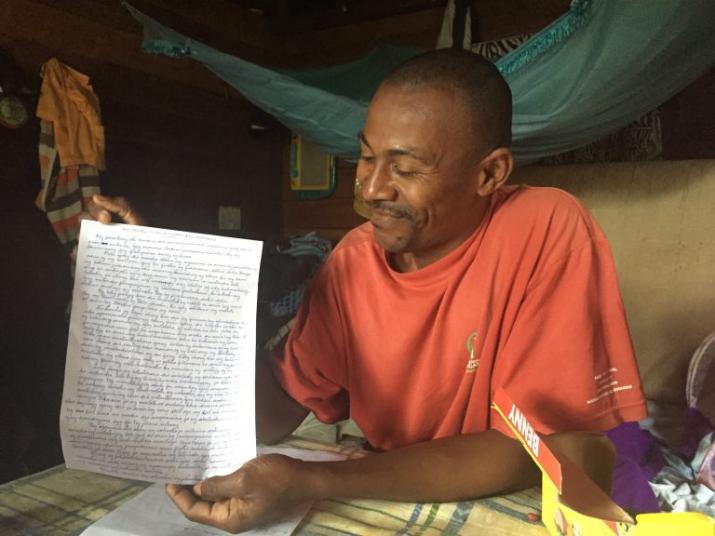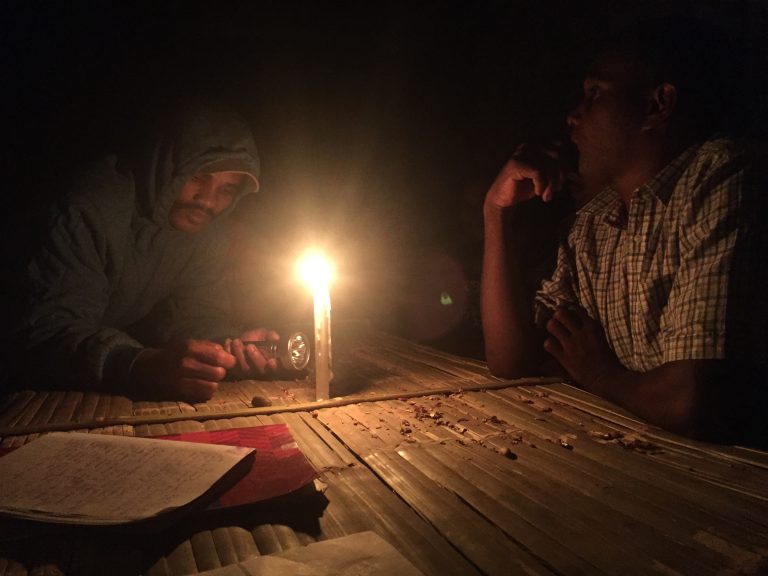
Felix, the president of the Mandena water association, holds up a letter to request money from local NGOs.
Published July 27, 2018 under Voices of DGHI
By Helena Merk, rising sophomore, computer science and global health major
For the past nine weeks, I was working in the village of Manantenina, Madagascar, with Duke Engineers for International Development. Throughout the academic year, we designed a water tap system, and the goal of our trip was to install the tap and consult with the village. But as with most international development projects, we ran into issues that we had not prepared for—which resulted in the project significantly changing scope soon after arrival.
Read Part 1, “Embracing the Unexpected,” to learn more about our project’s twists and turns or read on to learn how I applied my user-centered design experience to the project.
My years of work in app design—specifically, my work with user-centered design interfaces—provided me with skills that directly transferred to our project.
The first relevant lesson is designing for the user’s needs. In app design, this is the crux of success: it must be designed to fix a need – not a perceived need. In our case, this meant consultation was vital. It is easy to assume behaviors of locals. However, without extensive interviews, observation, and reflection, these assumptions can ruin a project. Naturally, we had to familiarize ourselves with the particulars of water usage and sanitation. But that alone is insufficient – we had to understand their thought process and gain enough perspective to step into their shoes. This meant inquiring about culture, family life, diet, livelihoods and more.
Another lesson was focus groups. In app design, testing a prototype is crucial to detecting early shortcomings. For us, this took the form of many meetings, the most productive of which were all-women meetings. The women and children are the only ones who fetch water, and therefore their input, concerns and questions about the taps were extremely valuable.
These women’s meetings were easily the most empowering parts of the trip. The first one I led was to discuss optimal tap placement. When I asked them to draw a map, at first, they refused and wanted to leave it to the men. Women in the community are often seen as incapable and are described as bad decision makers. After encouragement, however, the women mobilized and became fully invested. Through direct input, we were able to optimize the design to suit their needs most effectively.
A third applicable design strategy is studying existing, and successful, current models. With software development, a significant amount of open source technology is available, and forums flooding with advice are at your fingertips. In the SAVA region of Madagascar, information about a sustainable tap system design is more difficult to come by. All documentation has a single hand-written copy, people cannot be reliably reached by phone, and transportation is expensive. This limited our access to example tap systems to Ambohimanarina (1km away) and Maroambihy (3km away).
Although two villages is a small sample size, they provided us with a wealth of knowledge: both funded their pipelines with government funding, have established water associations, and have similar maintenance issues. We spoke with villagers and water association members alike, to garner both perceptions and quantitative data. This allowed us to advise Manantenina and Mandena’s water associations more effectively and helped us connect them with the other villages.
User-Centered International Development
Overall, I found the overlap between consumer software design and a water network design to be vast. This should be self-evident, as any design for a user should be user-centered. International development, however, often neglects to design with the user in mind.
International development efforts have the best intentions and projects often have lasting effects, bolstering a community and improving quality of life. However, far too often, international development projects fail because they are not designed for the user. Rather, needs are assumed.
Common failures I have observed, include the following:
- Irreplaceable imported materials are used. Specialized pieces are often expensive and not available to local technicians.
- Parts of the design are not locally compatible, socially taboo, or in general poorly designed for the environment.
- Locals aren’t equipped with the knowledge and tools to maintain the project.
- No initial community contribution (whether financial or physical) leads to a lack of community commitment.
I believe the root cause of these issues is the neglect of user-centered design. When designing software in the tech industry, interviews, profiling, prototyping and reiterating are valued. But when these steps are rushed or neglected, the project can still succeed: we have a baseline understanding of those in our community. When working abroad in a completely new culture, however, the importance of a proper design process increases exponentially. In addition, truly understanding the intricacies of the community is essential. With proper understanding of a community, and designing with the community in mind, the common pitfalls outlined above can be avoided and international development projects can more effectively reach their goals: to help lift a community out of systemic poverty cycles

A major goal of our trip was establishing a Water Association for Manantenina, to ensure the sustainability of our
project. In order for a tap network to last for decades, proper repairs and rules must be in place. This picture
depicts Donatien and Bi working late into the night: the association was tasked with the logistical nightmare of
taxation. Not only does the village not currently have a form of taxation, but money management techniques
are poor. This lack of an existing taxation system made this meeting even more challenging.

